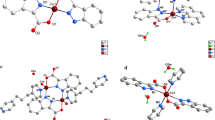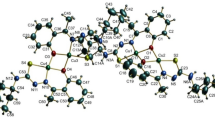Abstract
In this study, the various ligands axially coordinated to two cobalt center bound to the N4-oxime core in 12 new dicobaloxime/organodicobaloxime (1–12) complexes have been synthesized and characterized by NMR (1H and 13C), UV–Visible, FT-IR, LC–MS, molar conductivity analysis, melting point, and magnetic susceptibility experiments with elemental analysis. These spectroscopic results indicate that the formation of new dicobaloxime/organodicobaloxime (1–12) complexes. The (C=N–OH) peaks disappeared in the 1H-NMR spectrum of dicobaloxime/organodicobaloxime (1–12) complexes, while new peaks were observed at range 20.18–18.33 ppm, indicating that the groups of ligands have been transformed to intramolecular H-bridge (O–H⋯O). The dicobaloxime (1–6) species give a better cyclic voltammogram as compared to its organodicobaloxime derivatives (7–12) due to cyclic voltammograms of the organodicobaloximes (7–12) were poor. This is possibly due to the enhanced σ donation by R groups in the organocobaloximes which are substantially stabilized. The organodicobaloxime (10) showed much better catalytic activity compared to the other cobaoxime complexes.
Graphical Abstract
The different dicobaloxime (1–6) and organodicobaloximes (7–12) have been synthesized for the first time. Their redox properties were investigated using cyclic voltammetric (CV) techniques in a DMSO solution. These dicobaloximes/organodicobaloximes have been used as homogeneous catalyst for synthesis of cyclic carbonates presence of DMAP as co-catalyst.

















Similar content being viewed by others
References
Alici O, Karatas I (2016) Novel liquid crystal aldoximes and aldoxime ethers: synthesis, characterization and liquid crystal behavior. J Mol Liquids 221:1243–1248. doi:10.1016/j.molliq.2015.04.016
Al-Qaisi F, Genjang N, Nieger M, Repo T (2016) Synthesis, structure and catalytic activity of bis(phenoxyiminato)iron(III) complexes in coupling reaction of CO2 and epoxides. Inorg Chim Acta 442:81–85. doi:10.1016/j.ica.2015.11.023
Anastas PT, Lankey RL (2000) Life cycle assessment and green chemistry: the yin and yang of industrial ecology. Green Chem 2:289–295. doi:10.1039/B005650M
Artero V, Chavarot-Kerlidou M, Fontecave M (2011) Splitting water with cobalt. Angew Chem Int Ed 50:7238–7266. doi:10.1002/anie.201007987
Bai D, Nian G, Wang G, Wang Z (2013) Titanocene dichloride/KI: an efficient catalytic system for synthesis of cyclic carbonates from epoxides and CO2. Appl Organometal Chem 27:184–187. doi:10.1002/aoc.2967
Balzani V, Juris A, Venturi M, Campagna S, Serroni S (1996) Luminescent and redox-active polynuclear transition metal complexes. Chem Rev 96:759–834. doi:10.1021/cr941154y
Bard AJ, Faulkner LR (2001) Electrochemical methods: fundamentals and applications, 2nd edn. Wiley, New York
Brown KL (1972) Mechanism of base-catalyzed methane formation from methyl(aquo)cobaloxime. J Am Chem Soc 94:388–393
Castro-Gomez F, Salassa G, Kleij AW, Bo C (2013) A DFT study on the mechanism of the cycloaddition reaction of CO2 to epoxides catalyzed by Zn(Salphen) complexes. Chem Eur J 19:6289–6298. doi:10.1002/chem.201203985
Cini R, Moore SJ, Marzilli LG (1998) Strong trans influence methoxymethyl ligand in B12 cobaloxime and imine/oxime model complexes: structural, spectroscopic, and molecular mechanics investigations. Inorg Chem 37:6890–6896. doi:10.1021/ic980666i
Connolly P, Espenson JH (1986) Cobalt-catalyzed evolution of molecular hydrogen. Inorg Chem 25:2684–2688. doi:10.1021/ic00236a006
Cuesta-Aluja L, Campos-Carrasco A, Castilla J, Reguero M, Masdeu-Bultóa AM, Aghmiz A (2016) Highly active and selective Zn(II)-NN′O Schiff base catalysts for the cycloaddition of CO2 to epoxides. J CO2 Utiliz 14:10-22. doi: 10.1016/j.jcou.2016.01.002
Darensbourg DJ, Holtcamp MW (1996) Catalysts for the reactions of epoxides and carbon dioxide. Coord Chem Rev 153:155–174. doi:10.1016/0010-8545(95)01232-X
Dempsey JL, Brunschwig BS, Winkler JR, Gray HB (2009) Hydrogen evolution catalyzed by cobaloximes. Acc Chem Res 42:1995–2004. doi:10.1021/ar900253e
Dreos R, Randaccio L, Seiga P, Tavagnacco C, Zangrando E (2010) Guest driven self-assembly of a rectangular box from methylaquacobaloxime and 4,4′-biphenyldiboronic acid. Inorg Chim Acta 363:2113–2124. doi:10.1016/j.ica.2010.02.023
Du P, Knowles K, Eisenberg R (2008) A homogeneous system for the photogeneration of hydrogen from water based on a platinum(II) terpyridyl acetylide chromophore and a molecular cobalt catalyst. J Am Chem Soc 130:12576–12577. doi:10.1021/ja804650g
Dutta G, Gupta BD (2011) Cobaloximes with mixed dioximes having C and S side chains: synthesis, structure and reactivity. J Organomet Chem 696:2693–2701. doi:10.1016/j.jorganchem.2011.02.033
Dutta G, Mandal D, Gupta BD (2012) Pyrazine bridged dicobaloximes with bis(thiophenyl)glyoxime and their molecular oxygen insertion. J Organomet Chem 706–707:30–36. doi:10.1016/j.jorganchem.2012.01.009
Eckenhoff WT, McNamara WR, Du P, Eisenberg R (2013) Cobalt complexes as artificial hydrogenases for the reductive side of water splitting. Biochimica Biophysica Acta 1827:958–973. doi:10.1016/j.bbabio.2013.05.003
Herlinger AW, Ramakrishna K (1985) Synthesis and characterization of neutral ligand-bridged binuclear dialkylcobalt(III) complexes. Polyhedron 4:551–561. doi:10.1016/S0277-5387(00)86661-9
Kilic A, Ulusoy M, Durgun M, Tasci Z, Yilmaz I, Cetinkaya B (2010) Hetero- and homo-leptic Ru(II) catalyzed synthesis of cyclic carbonates from CO2; Synthesis, spectroscopic characterization and electrochemical properties. Appl Organomett Chem 24:446–453. doi:10.1002/aoc.1638
Kilic A, Palali AA, Durgun M, Tasci Z, Ulusoy M (2013a) The coupling of carbon dioxide and epoxides by phenanthroline derivatives containing different Cu(II) complexes as catalyst. Spectrochim Acta A 113:432–438. doi:10.1016/j.saa.2013.04.124
Kilic A, Palali AA, Durgun M, Tasci Z, Ulusoy M, Dagdevren M, Yilmaz I (2013b) Synthesis, characterization, electrochemical properties and conversions of carbon dioxide to cyclic carbonates mononuclear and multinuclear oxime complexes using as catalyst. Inorg Chim Acta 394:635–644. doi:10.1016/j.ica.2012.09.020
Kilic A, Kilic MV, Ulusoy M, Durgun M, Aytar E, Dagdevren M, Yilmaz I (2014) Ketone synthesized cobaloxime/organocobaloxime catalysts for cyclic carbonate synthesis from CO2 and epoxides: characterization and electrochemistry. J Organomet Chem 767:150–159. doi:10.1016/j.jorganchem.2014.05.023
Kilic A, Ulusoy M, Aytar E, Durgun M (2015) Mono/multinuclear cobaloxime and organocobaloxime-catalyzed conversion of CO2 and epoxides to cyclic organic carbonates: synthesis and characterization. J Ind Eng Chem 24:98–106. doi:10.1016/j.jiec.2014.09.015
Kilic A, Akdag S, Aytar E, Durgun M, Ulusoy M (2016) Design, synthesis and characterization of novel dioxime ligand-based cobaloxime compounds for application in the coupling of CO2 with epoxides. New J Chem 40:7901–7910. doi:10.1039/c6nj01223j
Kumar S, Seidel RW (2013) Ligand-bridged bicobaloximes synthesized by ligand replacement: synthesis, structure and characterization. Inorg Chem Commun 27:1–4. doi:10.1016/j.inoche.2012.10.019
Lawrence MAW, Celestine MJ, Artis ET, Joseph LS, Esquivel DL, Ledbetter AJ, Cropek DM, Jarrett WL, Bayse CA, Brewer MI, Holder AA (2016) Computational, electrochemical, and spectroscopic studies of two mononuclear cobaloximes: the influence of an axial pyridine and solvent on the redox behaviour and evidence for pyridine coordination to cobalt(I) and cobalt(II) metal centres. Dalton Trans 45:10326–10342. doi:10.1039/c6dt01583b
Lever ABP (1968) Inorganic electronic spectroscopy. Elsevier, Amsterdam
Martinez J, Castro-Osma JA, Earlam A, Alonso-Moreno C, Otero A, Lara-Sanchez A, North M, Rodriguez-Dieguez A (2015) Synthesis of cyclic carbonates catalysed by aluminium heteroscorpionate complexes. Chem Eur J 21:9850–9862. doi:10.1002/chem.201500790
Mirra S, Strianese M, Pellecchia C, Bertolasi V, Monaco G, Milione S (2016) Influence of coordinated ligands in a series of inorganic cobaloximes. Inorg Chim Acta 444:202–208. doi:10.1016/j.ica.2016.01.040
Moore EA and Janes R (2004) in Metal-Ligand Bonding, ed. E. W. Abel, RSC, ISBN: 978-0-85404-979-0
Nayak SC, Das PK, Sahoo KK (2003) Synthesis and characterization of some cobalt(III) complexes containing heterocyclic nitrogen donor ligands. Chem Pap 57(2):91–96
Niklas J, Mardis KL, Rakhimov RR, Mulfort KL, Tiede DM, Poluektov OG (2012) The hydrogen catalyst cobaloxime: a multifrequency EPR and DFT study of cobaloxime’s electronic structure. J Phys Chem B 116:2943–2957. doi:10.1021/jp209395n
Randaccio L (1999) Vitamin B, coenzyme models: perspectives on recent developments in the chemistry of the cobaloximes and related models. Comments Inorg Chem 21:327–376. doi:10.1080/02603599908012011
Razavet M, Artero V, Fontecave M (2005) Proton electroreduction catalyzed by cobaloximes: functional models for hydrogenases. Inorg Chem 44:4786–4795. doi:10.1021/ic050167z
Roberts GE, Heuts JPA, Davis TP (2000) Direct observation of cobalt−carbon bond formation in the catalytic chain transfer polymerization of methyl acrylate using matrix-assisted laser desorption ionization time-of-flight mass spectrometry. Macromolecules 33:7765–7768. doi:10.1021/ma0003506
Ruchi SC (2013) Synthesis, spectroscopic characterization, molecular modeling and antimicrobial activities of Mn(II), Co(II), Ni(II), Cu(II) complexes containing the tetradentate aza Schiff base ligand. Spectrochim Acta A 103:338–348. doi:10.1016/j.saa.2012.10.065
Schrauzer GN, Kohnle J (1964) Coenzym B12-modelle. J Chem Ber 97:3056–3064. doi:10.1002/cber.19640971114
Stolzenberg AM, Workman SR, Gutshall JE, Jeffrey E, Petersen L, Akhmedov N (2007) Syntheses and characterization of organo-group 14 cobaloxime compounds. Inorg Chem 46:6744–6754. doi:10.1021/ic070251+
Ulusoy M, Cetinkaya E, Cetinkaya B (2009) Conversion of carbon dioxide to cyclic carbonates using diimine Ru(II) complexes as catalysts. Appl Organomett Chem 23:68–74. doi:10.1002/aoc.1473
Ulusoy M, Kilic A, Durgun M, Tasci Z, Cetinkaya B (2011a) Silicon containing new salicylaldimine Pd(II) and Co(II) metal complexes as efficient catalysts in transformation of carbon dioxide (CO2) to cyclic carbonates. J Organometal Chem 696:1372–1379. doi:10.1016/j.jorganchem.2011.01.005
Ulusoy M, Sahin O, Kilic A, Buyukgungor O (2011b) Multinuclear Cu(II) schiff base complex as efficient catalyst for the chemical coupling of CO2 and epoxides: synthesis, X-ray structural characterization and catalytic activity. Cat Lett 141:717–725. doi:10.1007/s10562-010-0529-3
Wang M, Han K, Zhang S, Sun L (2015) Integration of organometallic complexes with semiconductors and other nanomaterials for photocatalytic H2 production. Coord Chem Rev 287:1–14. doi:10.1016/j.ccr.2014.12.005
Wani MY, Kumar S, Arranja CT, Dias CMF, Sobral AJFN (2016) Cycloaddition of CO2 to epoxides using di-nuclear transition metal complexes as catalysts. New J Chem 40:4974–4980. doi:10.1039/c5nj03198b
Xiang M, Meng QY, Li JX, Zheng YW, Ye C, Li ZJ, Chen B, Tung CH, Wu LZ (2015) Activation of C–H bonds through oxidant-free photoredox catalysis: cross-coupling hydrogen-evolution transformation of isochromans and β-keto esters. Chem Eur J 21:18080–18084. doi:10.1002/chem.201503361
Yamuna R, Sarath S, Kubandiran K, Umadevi M, Chakkaravarthi G (2016) Synthesis, characterization and thermal studies of 1,3-bis(4-pyridyl)propane bridged dicobaloximes. J Organomet Chem 811:40–47. doi:10.1016/j.jorganchem.2016.03.015
Yilmaz I, Kilic A, Yalcinkaya H (2008) Synthesis, characterization, fluorescence and redox features of new vic-dioxime ligand bearing pyrene and its metal complexes. Chem Papers 62(4):398–403. doi:10.2478/s11696-008-0046-7
Acknowledgement
We acknowledge the TUBITAK (Technological and Scientific Research Council of Turkey) for support of this research (Project No: 111T944).
Author information
Authors and Affiliations
Corresponding author
Rights and permissions
About this article
Cite this article
Kilic, A., Fırat, H., Aytar, E. et al. Dicobaloxime/organodicobaloximes bridged by different axial groups: synthesis, characterization, spectroscopy, and catalysis. Chem. Pap. 71, 1705–1720 (2017). https://doi.org/10.1007/s11696-017-0165-0
Received:
Accepted:
Published:
Issue Date:
DOI: https://doi.org/10.1007/s11696-017-0165-0




